LEI and KRWI Signal Imminent Recession, Is it Different This Time?
Economics / US Economy Apr 21, 2007 - 03:43 PM GMTBy: Paul_L_Kasriel
 The bulls on the economy had better hope it's different this time because both the index of Leading Economic Indicators (LEI) and the Kasriel Recession Warning Indicator (KRWI) are sending out recession warning signals now that March data are available. As I discussed in earlier commentaries (see The Econtrarian " Recession Imminent? Both the LEI and the KRWI are Flashing Warning " and The Econtrarian " When The Facts Change, I Change My Model - What Do You Do? "), year-over-year contractions in the quarterly average level of the LEI usually presage recessions, as shown in Chart 1.
The bulls on the economy had better hope it's different this time because both the index of Leading Economic Indicators (LEI) and the Kasriel Recession Warning Indicator (KRWI) are sending out recession warning signals now that March data are available. As I discussed in earlier commentaries (see The Econtrarian " Recession Imminent? Both the LEI and the KRWI are Flashing Warning " and The Econtrarian " When The Facts Change, I Change My Model - What Do You Do? "), year-over-year contractions in the quarterly average level of the LEI usually presage recessions, as shown in Chart 1.
The one exception to this since the 1960 recession occurred in late 1966 - early 1967, when an official recession did not occur although the pace of economic activity slowed sharply, prompting an easing of Federal Reserve monetary policy. Based on preliminary March LEI data, the first-quarter average LEI was 0.58% below its year-ago quarterly average. Assuming no major revisions to the January/February LEI, the month-to-month change in the March LEI would have to be revised up to 1.9% from its originally-reported 0.1% in order for the Q1:2007 LEI to be even with that of Q1:2006.
Revisions of this magnitude are rare. Also plotted in Chart 1 are the year-over-year percent changes in quarterly average levels of the index of Coincident Economic Indicators (CEI). The growth rate of the CEI in Q1:2007, at 1.8%, is down about 90 basis points from its Q3:2006 growth. Growth in the LEI shows the highest correlation (0.77) with growth in the CEI when the LEI growth is advanced by two quarters.
Chart 1
Index of Leading Indicators vs. Index of Coincident Indicators
year-to-year percent change
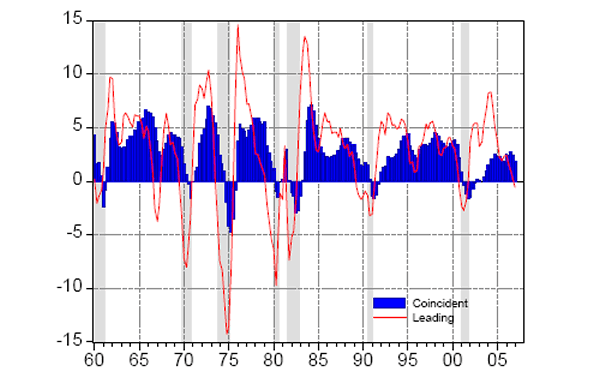
Corroborating the recession signal being sent by the LEI is the behavior of the ratio of the coincident indicators to the lagging indicators. This ratio tends to decline rapidly in advance of a recession. Chart 2 shows the relationship between the year-over-year growth in the LEI and the quarterly average behavior of the aforementioned ratio on a four-quarter moving average basis. Notice that the four-quarter moving average of the ratio, at 97.375, is already lower than its nadir in the past cycle.
Chart 2
LEIRatioLEI* vs. Ratio of Coincident to Lagging Indicators**
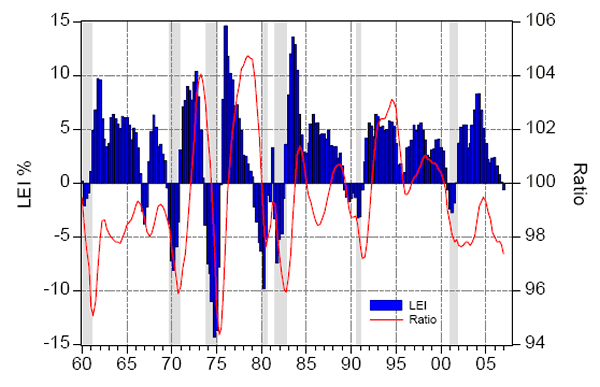
* year-over-year percent change
** 4-quarter moving average
To refresh your memory, the combination of a year-over-year contraction in the quarterly average of the CPI-adjusted monetary base (unadjusted bank reserves and currency held by the public) and a negative four-quarter moving average of the spread between the 10-year Treasury bond yield and the federal funds rate has signaled every recession since that of 1969. I have modestly named this combination the Kasriel Recession Warning Indicator. As shown in Chart 3, the KRWI is now sending out a recession warning as of the first quarter of this year in that the yield spread is negative and the real monetary base is contracting.
Chart 3
Kasriel Recession Warning Index*
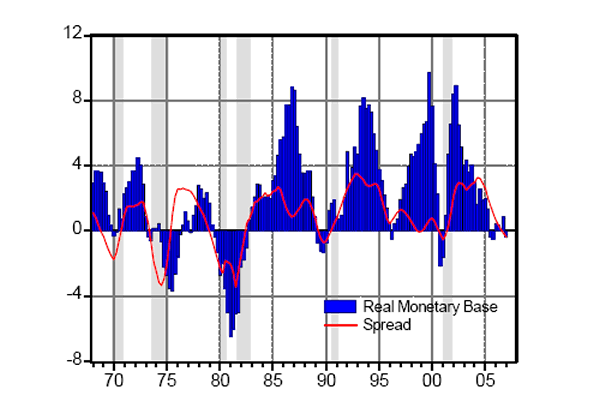
* Combination of year-over-year percent change in real monetary base and 4-qtr.
moving average percentage point spread between Treasury 10-yr. yield and fed funds rate
Are the LEI and the KRWI emitting false recession signals? Is it different this time? Let's look at the behavior of the three private-sector elements of aggregate domestic demand - housing, business capital spending and consumer spending to help us answer this question. Firstly, housing. Completions of new houses correlate highest on a coincident basis with the GDP line item, real residential investment expenditures. Chart 4 shows that the year-over-year behavior of new housing completions, down 19.50%, certainly suggests a recession is imminent, if not already upon us.
Chart 4
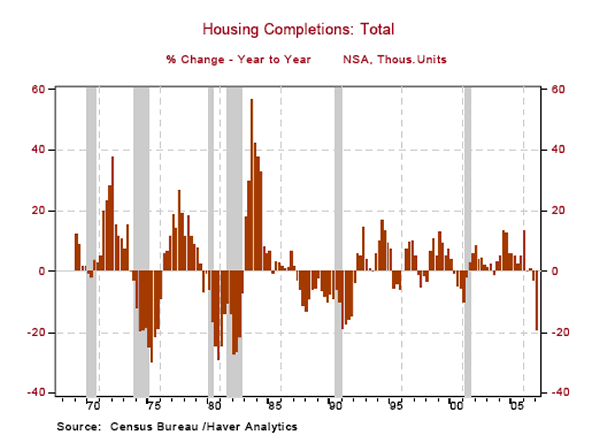
Chart 5 shows the year-over-year change in price-adjusted shipments of nondefense capital goods, excluding aircraft. Although not as dramatic a decline as housing completions, real shipments of nondefense capital goods ex aircraft fell off a cliff starting in December of last year, declining year-over-year in each of the three months ended February.
Chart 5

Chart 6 shows the year-over-year change in retail sales adjusted for prices. This series shows much less of a definitive trend than the prior two series in Charts 4 and 5. But real retail sales growth slowed to 2.11% on a year-over-year basis in Q1:2007, down from 5.05% growth in Q4:2006.Given that mortgage equity withdrawal has collapsed and year-over-year growth in employment has slowed, this latest deceleration in real retail sales growth may be the beginning of the real deal.
Chart 6
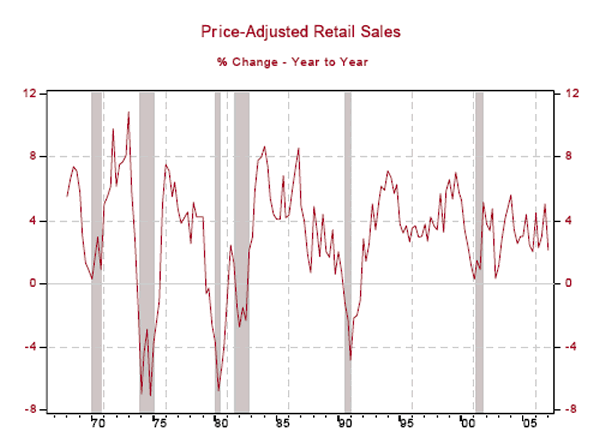
Related to employment growth is unemployment growth. Chart 7 shows the behavior of initial jobless claims. On a year-over-year basis, they are rising, which is a typical prelude to recession.
Chart 7
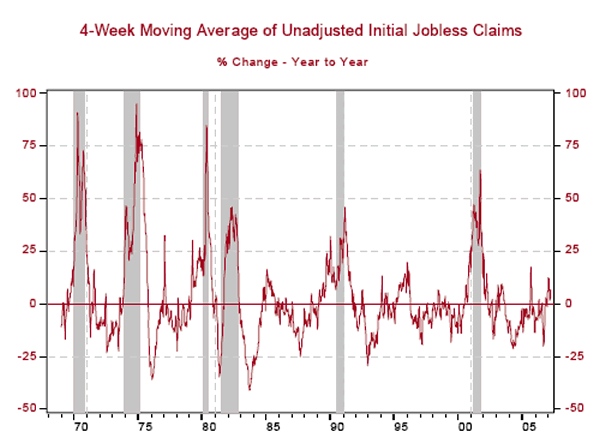
I am not aware that any recession has been predicted by a consensus of economic prognosticators. Two reliable recession indicators are now flashing a warning signal and private domestic demand is showing weakness. Maybe it's different this time? Perhaps it isn't. Only the National Bureau of Economic Research will know for sure.
*Paul Kasriel is the recipient of the 2006 Lawrence R. Klein Award for Blue Chip Forecasting Accuracy
By Paul Kasriel
The Northern Trust Company
Economic Research Department - Daily Global Commentary
Copyright © 2007 Paul Kasriel
Paul joined the economic research unit of The Northern Trust Company in 1986 as Vice President and Economist, being named Senior Vice President and Director of Economic Research in 2000. His economic and interest rate forecasts are used both internally and by clients. The accuracy of the Economic Research Department's forecasts has consistently been highly-ranked in the Blue Chip survey of about 50 forecasters over the years. To that point, Paul received the prestigious 2006 Lawrence R. Klein Award for having the most accurate economic forecast among the Blue Chip survey participants for the years 2002 through 2005.
The opinions expressed herein are those of the author and do not necessarily represent the views of The Northern Trust Company. The Northern Trust Company does not warrant the accuracy or completeness of information contained herein, such information is subject to change and is not intended to influence your investment decisions.
© 2005-2022 http://www.MarketOracle.co.uk - The Market Oracle is a FREE Daily Financial Markets Analysis & Forecasting online publication.


